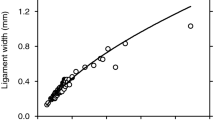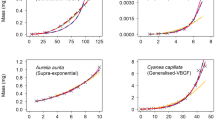Abstract
Allometric growth investigations are usually conducted by fitting the allometric model (L) \( y = ax^{b} \Leftrightarrow \log y = \log a + b\log x \) (y, x are morphometric characters and b the allometric exponent), which is quite simple both conceptually and mathematically, and its parameters are easy to estimate by linear regression. However b is not necessarily constant and it may change either continuously or abruptly at specific breakpoints; thus, the simple L model quite often fails to describe allometric growth successfully. In the current context, a better alternative is proposed, based on Kullback–Leibler (K-L) information theory and multi-model inference (MMI). Allometric growth was investigated in eight marine species: the bivalves Pecten jacobaeus and Pinna nobilis, the squids Todarodes sagittatus and Todaropsis eblanae, the crab Pachygrapsus marmoratus (females), the ghost shrimp Pestarella tyrrhena (males), and the fishes Trachurus trachurus and Sparus aurata. In each of the eight species, a pair of body parts was measured and the allometric growth of one body part in relation to the other (reference dimension) was studied, by fitting five different candidate models including: the simple allometric model, two models assuming that b changed continuously and two other assuming that b had a breakpoint. For each species, the ‘best’ model was selected by minimizing the small-sample, bias-corrected form of the Akaike Information Criterion. To quantify the plausibility of each model, given the data and the set of five models, the ‘Akaike weight’ wi of each model was calculated; based on wi the average model was estimated for each case. MMI is beneficial, more robust, and may reveal more information than the classical approach. As demonstrated with the given examples, estimation of b from the linear model, when it was not supported by the data, revealed some characteristic pitfalls, such as concluding positive allometry when there is actually negative or vice versa, or reporting allometry when the data in reality support isometric growth or vice versa.





Similar content being viewed by others
References
Akaike H (1973) Information theory and an extension of the maximum likelihood principle. In: Petrov BN, Csaki F (eds) Second international symposium on information theory. Akademiai Kiado, Budapest, pp 267–281
Akaike H (1981) Likelihood of a model and information criteria. J Econom 16:3–14
Akaike H (1983) Information measures and model selection. Int Stat Inst 44:277–291
Buckland ST, Burnham KP, Augustin NH (1997) Model selection: an integral part of inference. Biometrics 53:603–618
Burnham KP, Anderson DR (2002) Model selection and multimodel inference: a practical information-theoretic approach, 2nd edn. Springer, Berlin Heidelberg New York
Ebert TA, Russell MP (1994) Allometry and Model II non-linear regression. J Theor Biol 168:367–372
Hall NG, Smith KD, de Lestang S, Potter IC (2006) Does the largest chela of the males of three crab species undergo an allometric change that can be used to determine morphometric maturity? ICES J Mar Sci 63:140–150
Hoeting JA, Madigan D, Raftery AE, Volinsky CT (1999) Bayesian model averaging: a tutorial (with discussion). Stat Sci 14:382–417
Hurvich CM, Tsai CL (1989). Regression and time series model selection in small samples. Biometrika 76:297–307
Huxley JS (1932) Problems of relative growth. Methuen, London
Jolicoeur P (1990) Bivariate allometry: interval estimation of the slopes of the ordinary and standardized major axes and structural relationship. J Theor Biol 144:275–285
Katsanevakis S (2005a) Abundance and spatial distribution of the Mediterranean scallop, Pecten jacobaeus, in a marine lake. Fish Res 76:417–429
Katsanevakis S (2005b) Population ecology of the endangered fan mussel Pinna nobilis in a marine lake. Endanger Species Res 1:1–9
Katsanevakis S (2006) Modelling fish growth: model selection, multi-model inference and model selection uncertainty. Fish Res 81:229–235
Kullback S, Leibler RA (1951) On information and sufficiency. Anal Math Stat 22:79–86
Laws EA, Archie JW (1981) Appropriate use of regression analysis in marine biology. Mar Biol 65:13–16
McQuarrie ADR, Tsai CL (1998) Regression and time series model selection. World scientific publishing company, Singapore
Prairie YT, Peters RH, Bird DF (1995) Natural variability and the estimation of empirical relationships: a reassessment of regression methods. Can J Fish Aquat Sci 52:788–798
Protopapas N (2006) Biology of the grapsid crab Pachygrapsus marmoratus. MSc thesis. National and Kapodistrian University of Athens, Athens
Ricker WE (1973) Linear regression in fishery research. J Fish Res Board Can 30:409–434
Schafer DW, Purdy KG (1996) Likelihood analysis for errors-in-variables regression with replicate measurements. Biometrika 83:813–824
Shea EK, Vecchione M (2002) Quantification of ontogenetic discontinuities in three species of oegopsid squids using model II piecewise linear regression. Mar Biol 140:971–979
Sokal RR, Rohlf FJ (1995) Biometry. Freeman, New York
Somerton DA (1981) Regional variation in the size of maturity of two species of tanner crab (Chionoecetes bairdi and C. opilio) in the eastern Bering Sea, and its use in defining management subareas. Can J Fish Aquat Sci 38:163–174
Acknowledgments
We would like to thank N. Zikos, who measured the beaks of T. eblanae and T. sagittatus. We acknowledge the valuable comments of two anonymous referees that greatly improved this manuscript.
Author information
Authors and Affiliations
Corresponding author
Additional information
Communicated by O. Kinne, Oldendorf/Luhe.
Rights and permissions
About this article
Cite this article
Katsanevakis, S., Thessalou-Legaki, M., Karlou-Riga, C. et al. Information-theory approach to allometric growth of marine organisms. Mar Biol 151, 949–959 (2007). https://doi.org/10.1007/s00227-006-0529-4
Received:
Accepted:
Published:
Issue Date:
DOI: https://doi.org/10.1007/s00227-006-0529-4




